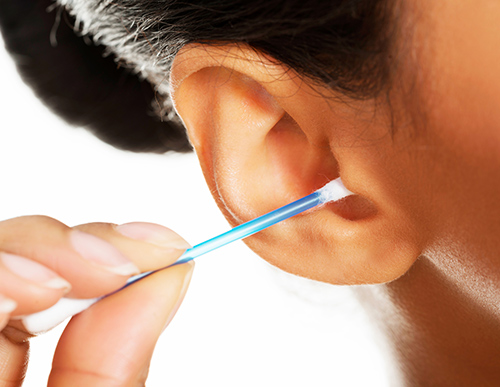
The American Academy of Otolaryngology-Head and Neck Surgery (AAO-HNS), your local hearing care professional, your grandmother and all the boxes of swabs everywhere: you need to stop cleaning your ears with swabs or any other pointy object smaller than your elbow. We now know that ear cleaning is largely unnecessary—and doing it with a swab, ear candle or other pointy implement is downright harmful. The old “elbow in the ear” saying rings true scientifically. These 5 surprising reasons should make you stop cleaning your ears from now on:
1. Ears Clean Themselves Quite Effectively Already
Cerumen is the official, scientific term for ear wax. And while it may look disgusting, it’s actually a cleaning workhorse, especially formulated to protect your ears from environmental dust and debris that may try to get into your ear canals. Not only that, but without realizing it, you actually already help your ears clean themselves. As you talk, yawn or chew throughout the day, those actions gently move the soiled ear wax out of the ear canal. The only cleaning you need to do is to gently wash the expelled ear wax out of the opening during your shower.
When you try to use a swab, stick, key, fork, finger, chopstick or any other pointy object for ear wax removal, you actually reverse your ear’s cleaning process by pushing old ear wax back down into the canal where it can become impacted and cause hearing loss or infection.
2. And They Use Ear Wax to Do It
Although nobody ever wants to pop an ear wax flavored Bertie Bott’s Every Flavor Beans jellybean, cerumen (scientific-speak for ear wax) has all kinds of health properties that help keep your ears healthy. Ear wax has several health benefits aside from moving the dirt out of your ears. It protects your ears against viruses, fungal infections, bacteria, and even insects! It also moisturizes and conditions the skin inside of the ear canal, keeping it healthy and supple.
Cerumen is a fascinating recipe of long-chain fatty acids, cholesterol, alcohols, sebum, sloughed off skin cells, enzymes and other chemicals that are produced by special glands inside your ears. Your ears concoct this special recipe to keep your ears clean and infection free. In fact, average cerumen is slightly acidic—which inhibits fungal and bacterial growth. Yay ear wax!
3. The Ear Wax Removal-Hearing Loss Connection
One of the reasons so many people walk around with some level of hearing loss without realizing it is actually aggressive ear wax removal. As you shove those swabs into your ear, old layers of ear wax get impacted further down into the ear canal, causing some hearing loss.
If you’re worried this may have happened to you, schedule an appointment with your hearing care professional for a hearing checkup to determine whether or not you have impacted ear wax that might be causing some amount of hearing loss. Impacted ear wax removal should only be done in the office and without any pointy objects like swabs.
To be fair, some people have ear wax production issues that need to be addressed with ear wax removal. Some people’s ears make cerumen that’s either too dry or too wet, so it doesn’t properly do its job. Some people make way too much ear wax while others don’t make enough. Even in these cases, however, you still need to avoid sticking swabs into your ears for ear wax removal. Call your hearing care professional if you’re worried about your ear wax.
A quick thought about hearing aids: If you wear hearing aids, you need to follow your hearing care professional’s hearing aid cleaning regimen and any ear washing regimen you’re instructed to follow. This will help preserve what natural hearing you still have while also keeping your hearing aids performing at their best.
4. Prevent Ear Cleaning Injuries Like These
Nearly 12,500 American kids a year have to go to the doctor with ear wax removal injuries. Unfortunately, these injuries can negatively affect a child’s language and communication development if the ear cleaning injury results in hearing loss. The most common of these ear injuries include tympanic membrane tears (torn ear drum) or other small lacerations and cuts inside of the ear canal. Pass on what you have learned: never stick anything into your ear but your elbow (it’s cute when they try to stick their elbow in there).
And now, about ear candling for ear cleaning… just don’t. The person responsible for the idea of sticking a hollow cone into the ear and lighting it has been lost to history, which is just as well. It was never a good idea and can damage your hearing and cause other injuries too. Thousands of people experience ear candling injuries each year, and for what?
- It’s been proven ineffective for ear cleaning and can actually make ear wax impaction worse.
- It causes burn injuries to the face, ears, hair, etc. – even burns that go all the way to the ear drum and middle ear.
- It’s also been known to puncture the ear drum.
So please – run away from ear candling.
5. A Gentle Rinse in the Shower and Your Ears are Happy
All you need to do, really, is shower and wash your hair. Then just gently dab around your ears with a towel to sop up any excess water and you’re done. This will safely remove only the spent ear wax that your chewing, talking and yawning have evacuated from the ear canal.
Seriously – don’t pick up another swab! If not cleaning your ears the wrong way makes you feel awkward, or if you have any other concerns about ear wax impaction, ear injury or hearing loss, please schedule an appointment with your hearing care professional for an ear checkup today.
